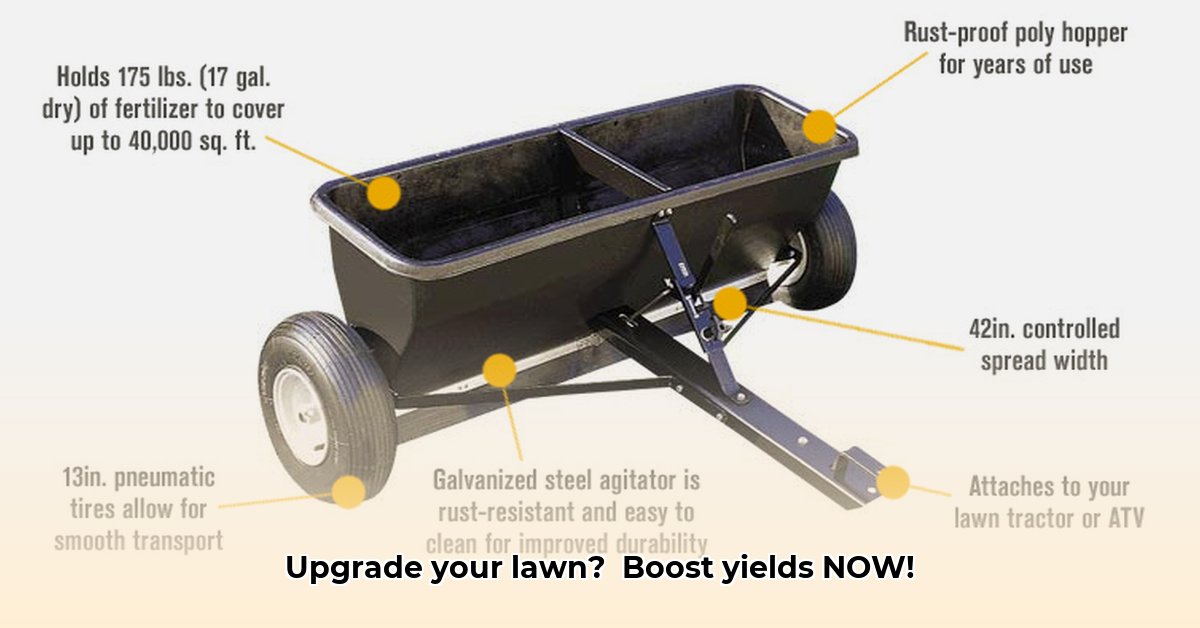
Understanding Drop Spreaders: Precision Fertilizing for Sustainable Agriculture
Precision fertilizer application is crucial for maximizing yields while minimizing environmental impact. Drop spreaders offer a targeted approach, delivering fertilizer directly to the target area, unlike broadcast spreaders which cast fertilizer widely, leading to potential waste and runoff. This focused application translates to significant cost savings and a lighter environmental footprint. This guide empowers you to master drop spreaders, enhancing your farm's sustainability and productivity. For more information on 3-point hitch spreaders, check out this helpful resource: 3-point hitch spreaders.
Types of Drop Spreaders: Finding the Right Fit for Your Operation
Drop spreaders cater to diverse farming needs. Smaller, tow-behind models are ideal for smaller operations or specialized applications, while larger, self-propelled models suit larger farms and varied terrains. Consider the following factors when selecting a drop spreader:
- Hopper Capacity: This dictates how much fertilizer you can apply before refilling. Larger hoppers mean fewer refills, but also greater weight. Choose a capacity appropriate to your field size and the time you want to dedicate to refilling.
- Spreading Width: This determines the swath width covered in a single pass. Wider widths improve efficiency for larger fields, while narrower widths offer greater precision for smaller areas or intricate layouts.
- Material Compatibility: Ensure your chosen spreader is compatible with your preferred fertilizer type. Some spreaders are designed for granular fertilizers, while others handle liquid fertilizers. Check manufacturer specifications carefully.
- Durability and Build Quality: Invest in a sturdy, well-built spreader constructed from corrosion-resistant materials to ensure longevity and continued performance. A high-quality spreader will endure years of use, offsetting the initial investment.
- Budget: Spreaders vary greatly in price. Allocate a budget that aligns with your operational scale and long-term needs.
How to Choose a Drop Spreader: A Decision-Making Framework
Selecting the right drop spreader involves considering several key factors, including:
- Farm Size: Larger farms often require larger-capacity spreaders to minimize refill time and optimize efficiency. Smaller farms may find smaller models more practical.
- Terrain: Uneven terrain might necessitate a more robust spreader with better maneuverability. Flat fields can accommodate less rugged models.
- Fertilizer Type: Different spreaders are designed for various fertilizer types. Ensure compatibility with your intended fertilizer.
- Budget: Establish a clear budget before beginning your search. Consider the long-term costs of ownership, including maintenance and repairs.
- Maintenance Requirements: Some spreaders require more frequent or extensive maintenance than others. Choose a model that aligns with your available resources and time constraints.
Setting Up and Using a Drop Spreader: A Practical Step-by-Step Guide
Mastering your drop spreader requires careful setup and operation. Always consult your specific spreader's manual for detailed instructions and safety precautions.
Step 1: Calibration: Accurate calibration is essential for consistent fertilizer distribution. Your spreader's manual provides instructions for adjusting the settings according to your desired application rate. Inaccurate calibration can lead to wasted fertilizer or uneven growth.
Step 2: Fertilizer Loading: Load the fertilizer into the hopper, avoiding overfilling to prevent spillage. Never exceed the maximum capacity indicated in the manual.
Step 3: Attachment and Operation: Securely attach the spreader to your tractor, following the manufacturer's instructions. Begin with slow, overlapping passes to ensure even coverage. Adjust the tractor's speed as needed to maintain optimal spreading.
Step 4: Safety Precautions: Always wear appropriate safety gear, including eye protection and gloves. Keep children and animals away from the application area.
Maintenance and Troubleshooting: Ensuring Optimal Performance
Regular maintenance prolongs your spreader's lifespan and ensures optimal performance. After each use, clean the spreader thoroughly to remove any fertilizer residue. Lubricate moving parts as recommended in the manual. Address any clogs promptly to prevent uneven distribution. Consult the manual for troubleshooting common issues.
Drop Spreaders vs. Broadcast Spreaders: A Comparative Analysis
While broadcast spreaders offer speed and wide coverage, drop spreaders provide superior precision, reducing fertilizer waste and environmental impact. The choice depends on your farm's scale and priorities. While broadcast spreaders require a lower initial investment, the long-term cost of fertilizer waste can outweigh this advantage. Drop spreaders represent a more sustainable and potentially cost-effective solution long term. A well-calibrated, appropriately chosen drop spreader will deliver superior results over time.
Conclusion: Embrace Precision for Sustainable Agriculture
Implementing drop spreaders translates to cost savings, improved yields, and a reduced environmental footprint. Mastering this technology empowers you to optimize fertilizer use, enhancing both profitability and sustainability. By following this guide and adhering to the safety instructions, you'll unlock the full potential of precision fertilizer application.